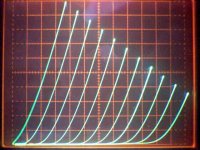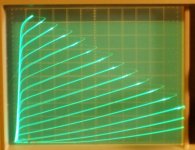Remember that lossy compression such as 320kbps MP3/AAC is indistinguishable from lossless in many cases for many people, yet can be up to 50% THD.
Do you have a reference for that? I've measured THD many times with even lower rate MP3, and have never seen anything remotely approaching 50% THD or even 5%. Remember, THD is measured with just 1 tone (!) so the "lossy" compression of MP3 is pretty much lossles in that circumstance.
Tubes have more gain with less distortion w/o Feedback than transistors.
I don't think that generalization holds water, either. It's not that simple, nor even true IMO.
I have an amp design that does 60W, single ended class A, zero global feedback, output impedance under a quarter ohm across the band, full power efficiency above 40%, and full power harmonic distortion is under 0.3%, mostly 2nd and 3rd. At watt levels, it's well under 0.1%, almost all 2nd harmonic. It's an entirely solid state design. Are there any tube amps that do that (assuming it matters, which it probably doesn't)?
I don't disagree that high output impedance and significant low order distortions can make for pleasing sound with some speakers and if it's liked, and there's nothing wrong with using them if it helps the illusion.
Last edited:
how can a harmonic be lower than the fundamental?
If you google "missing fundamental" you'll find many resources that can explain in depth.
For example the fundamental of an adult male is somewhere around 150hz. Now when they were inventing the telephone they heavily researched into the minimum frequency range to use, while still remaining highly intelligible. They landed on (and is still used today) 300hz to 3khz.
Because all of the harmonics are present of 150hz (300...450...etc) the brain can "fill in" the missing fundamental.
Now if we apply this to speakers, imagine we have a SET Amp with monotonic distortion that decreases in power vs order (high second.. lower third.. lower forth.. etc). This completely is accepted by our brain as it is perceived as natural/real distortion as it mimicks harmonic structure in nature. If we play this through speakers that have a FR of 40hz-20khz, you will actually auditorily perceive 20hz-20khz, more so if the signal has harmonics present than pure sine waves.
Why? Because if we play a note on a musical instrument with a fundamental of 40hz, and all the harmonics are present, the "natural" harmonics in the amplifier add to what's in the sound signal, possibly becoming audible. If audible, it creates the distortion spectrum that allows the brain to "fill in" the missing fundamental- if present or not.
Last edited:
Do you have a reference for that? I've measured THD many times with even lower rate MP3, and have never seen anything remotely approaching 50% THD or even 5%. Remember, THD is measured with just 1 tone (!) so the "lossy" compression of MP3 is pretty much lossles in that circumstance.
I don't think that generalization holds water, either. It's not that simple, nor even true IMO.
I have an amp design that does 60W, single ended class A, zero global feedback, output impedance under a quarter ohm across the band, full power efficiency above 40%, and full power harmonic distortion is under 0.3%, mostly 2nd and 3rd. At watt levels, it's well under 0.1%, almost all 2nd harmonic. It's an entirely solid state design. Are there any tube amps that do that (assuming it matters, which it probably doesn't)?
I don't disagree that high output impedance and significant low order distortions can make for pleasing sound with some speakers and if it's liked, and there's nothing wrong with using them if it helps the illusion.
My reference is Dr. Geddes' AES paper (II) on distortion perception, second paragraph. Now where he get's that info, I have no idea. Dr. Geddes' is a hell of a smart man though, and from what I understand these are peer reviewed papers. http://www.gedlee.com/downloads/Distortion_AES_II.pdf
On that note, does anyone understand transfer functions of amplifiers and how to measure them? I haven't been able to find any information on google pertaining to stereo amplifiers.
Sounds like an awesome amplifier! What about local feedback or degeneration though?
Also, wth is it? Those measurements are better than Pass' firstwatt designs.
Last edited:
I didn't realise we were discussing Psychoacoustics!
Sure Pano, the timbre of any instrument or voice is the result of the distribution of harmonics. If my piano technician were to tone down the hammers on my Steinway until every note sounded like a tuning fork, I certainly would not be happy.
However, from an electronic point of view, I think the first paragraph of post 27 is very apposite.
Sure Pano, the timbre of any instrument or voice is the result of the distribution of harmonics. If my piano technician were to tone down the hammers on my Steinway until every note sounded like a tuning fork, I certainly would not be happy.
However, from an electronic point of view, I think the first paragraph of post 27 is very apposite.
Could be. But ask Wavebourn if he, or anyone he knows, has ever gotten an amp to sound sweet by adding low order harmonics. It isn't as easy as it seems.
My reference is Dr. Geddes' AES paper (II) on distortion perception, second paragraph. Now where he get's that info, I have no idea. Dr. Geddes' is a hell of a smart man though, and from what I understand these are peer reviewed papers. http://www.gedlee.com/downloads/Distortion_AES_II.pdf
I'm baffled on where he got that. I've even used mp3 to measure speaker distortion (which is nearly always high enough that it doesn't take too clean gear to do it with), never saw anything near that. (That's a "Convention Paper", though, not an AES Journal paper, no peer review. But I should ask Earl about it.).
Sounds like an awesome amplifier! What about local feedback or degeneration though?
Also, wth is it? Those measurements are better than Pass' firstwatt designs.
It does use local feedback and degeneration. That's how the output impedance can be so low and the input stage so clean. The output is "Szlikai Pair" emitter follower.
But triode tubes, even if not externally degenerated, also have local feedback from their internal space charge. And pentodes (which removes the space charge feedback) aren't even particularly linear, though they do tend to have lots more gain than triodes which lose gain from their internal feedback. Tube amps without any degeneration applied are rare and still have internal local feedback. Without feedback, most amplifying devices aren't very linear (a possible exception is some power MOSFETs when run at very high idle currents, but that's higher than they can usually live running at at usable voltages).
The amp mentioned is a larger and more refined version of the "Spring Amp" that was published earlier this year in Linear Audio. Basically, a two stage amp (voltage gain stage followed by current-gain follower) both stages made up of compound devices of Szlikai pairs and/or cascodes. The efficiency is because of its using an inductor-fed output, similarly to how the output runs in SET amps, but without needing the impedance transformation of the output transformer. Class A amplifiers using inductor (or gapped output transformer) can have as high theoretical efficiency as class A push-pull. Limited of course by devices and circuit losses... The 2nd Spring amp pushes out the losses as much as practical.
That's "full power" efficiency, though, which is kind of an irrelevant specification since single-ended class A burns as much power at full power output as it does at zero power output 🙄! Since the average output power of a hifi audio amp is very low, the actual efficiency of the Spring amps with music is also still very low. Not as low as typical SET, but still pretty low in practical terms. The big "2nd Spring" amp burns about as much power at idle as does the old McIntosh MC60 (per it's spec sheet) vacuum tube amp , which runs almost in class B, so it's nothing to sneeze at. Nothing like the efficiency of a class AB or class D SS amp, though as you'd expect!
" Are there any tube amps that do that?"
Hmmmm, with the right super tubes, the latest tube circuit techniques, and local N Fdbk, should be possible. Not ordinarily possible though.
Hmmmm, with the right super tubes, the latest tube circuit techniques, and local N Fdbk, should be possible. Not ordinarily possible though.
Attachments
Thank you for your opinion, and I do not disagree with you. I just want to hear opinions from someone who find non flat response has certain advantage over flat one. If I go to an audio forum where people just talk about their sujective preference, I think I can find someone who prefer non flat amp over flat one without knowing what's going on, but I was wondering if someone very knowlegeable in this forum could explain more scientifically why this kind of non lineality is preffered by not a small number of audiophiles. We all know the reason why many people accept or prefer non linearlity such as second harmonics, but I had never heard the reason why low frequency 2nd harmonics is more acceptable or preferable than higher frequency 2nd harmonics.
Yeah, like opinions of people who believes that adding some spoon of a gasoline to the glass of water that already have a drop of a cyanide makes it less poisonous. ;-)
Good luck to find some scientific, or even based on own experience, explanation!

What does mean, "but I had never heard the reason why low frequency 2nd harmonics is more acceptable or preferable than higher frequency 2nd harmonics" is some sur-realistic question, not for this forum
Could be. But ask Wavebourn if he, or anyone he knows, has ever gotten an amp to sound sweet by adding low order harmonics. It isn't as easy as it seems.
Search for "Harmonizer" that I posted several years ago. I used it to open ears to people who claimed that they like low order harmonics. 😀
Because all of the harmonics are present of 150hz (300...450...etc) the brain can "fill in" the missing fundamental.
Sure, without any additional intermodulation due to non-linearities of a sound reproduction. ;-)
I'm a SET no NFB guy. My opinion is that any amplifier should have as little of distortion as possible. The first criteria are measurements, but the final judge for sound quality should be the ears. There are many myths about the subjective sound quality of SETs all over the internet - lack of bass, slow and calm sound, muddy for complex music. No. A well made SET has fast and clean bottom end, has jumping, hair rising attacks and can play any kind of music with ease. It can even be made to sound more sterile than a SS amplifier.
Your two sentences seem to say opposite things.50AE said:I'm a SET no NFB guy. My opinion is that any amplifier should have as little of distortion as possible.
Ears are more easily confused than instruments. We need both. Measurements tell us what is happening. Ears tell us whether we like the result, but not necessarily whether the result is a faithful reproduction of the input.The first criteria are measurements, but the final judge for sound quality should be the ears.
And when it becomes unfaithful, we have to make a auditory judgement of what is noticeable, what is objectionable, etc. That leads to a lot of confusion.
A high performance SE amp is intrinsically very expensive but surely many of the skilled members of this forum have managed to build such. I wonder, though, if is it really possible to reconcile the contradictory requirements of the output transformers without taking the most extreme measures. What I really cannot understand is how it is possible to look at a set of valve characteristic curves (any valve) and maintain that distortion can possibly be minimised without using any feedback.
There's a good section in the Langford-Smith book where he plots virtual characteristic curves to help visualise the effects of feedback. (I say virtual because the actual valve operation doesn't change per se, it is the performance of the circuit).
There's a good section in the Langford-Smith book where he plots virtual characteristic curves to help visualise the effects of feedback. (I say virtual because the actual valve operation doesn't change per se, it is the performance of the circuit).
Last edited:
Wavebourn's "Harmonizer" thread makes a very amusing read indeed! (I didn't remember it) It also manages to stay very harmonious.
Your two sentences seem to say opposite things.
The minimum distortion achievable for a current topology, I meant. A push-pull solid state with a good amount of NFB might have a lesser measurable distortion than a no NFB SET. But I think it's would be more correct to compare a SET to another SET amplifier. Building the later with good measurable specs is a challenge, but it can be done. It depends of what someone considers "good specs"
Ears are more easily confused than instruments. We need both. Measurements tell us what is happening. Ears tell us whether we like the result, but not necessarily whether the result is a faithful reproduction of the input.
There are many definitions standing for faithful reproductions of the input. And it's a matter of subjective opinions. Some watch the digits. Others listen and compare. A few do both. I see no universal truth here.
OK. I didn't realise that when you said "possible" you meant possible for that topology, not possible for reasonable state of the art audio - which may involve a different topology.The minimum distortion achievable for a current topology, I meant.
I can only think of one: output = bigger version of input.There are many definitions standing for faithful reproductions of the input.
That is where we differ.I see no universal truth here.
- Home
- Amplifiers
- Tubes / Valves
- Ideal THD vs Frequency for SET


